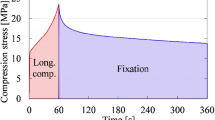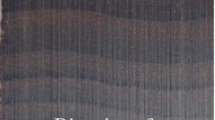Abstract
During the wood drying process, mechanical stresses and thermal conditions arise, which causes irreversible damage. Since drying of wood results in a general improvement of strength and elasticity, the negative drying effects are covered. In the present study, the mechanical properties of dried and subsequently re-moistened samples were compared to native wet wood. For oven dried/re-moistened macro-scale bending and compression strength a significant reduction of 16.5% and 15.0% was observed. Micro-scale specimens underwent a similar strength loss, i.e. 9.8% for tensile strength and 14% for compression strength. When the drying was performed at ambient temperature (20°C), no difference to native wood was observed in tensile testing, whereas a significant reduction of compression strength (10.0%) was found. SEM micrographs of tensile fracture surfaces of dried and re-moistened specimens showed a brittle and rather smooth transwall failure of tracheids, whereas native samples exhibited a more ductile character.
Zusammenfassung
Während der Holztrocknung kommt es neben makroskopischen Spannungen auch zu mikroskopischen Spannungszuständen, sowie zu thermischen Veränderungen der Zellwandsubstanzen, die zu einer irreversiblen Schädigung der Holzsubstanz führen. Da ein Feuchtigkeitsentzug aus der Zellwand allgemein eine Verfestigung der Holzsubstanz verursacht, werden die Festigkeitsverluste während der Holztrocknung durch die zu vor geschilderte Verfestigung überdeckt. Durch den Vergleich von frischen und nach der Trocknung (103°C) wieder befeuchteten Proben konnte für makroskopische Biege- und Druckproben ein Festigkeitsverlust von 16.5% bzw. 15.0% nachgewiesen werden. Mikroskopische Zug- und Druckproben zeigten bei 103°C ähnliche hohe Verluste von 9.8 bzw. 14%. Trocknung bei 20°C führte nur bei den Druckproben zu einem signifikanten Festigkeitsverlust von ca. 10%. SEM Aufnahmen der Bruchflächen von Mikro-Zugproben zeigten ein glattes, sprödes Bruchbild bei den getrockneten/wiederbefeuchteten Proben. Hingegen waren die frischen Proben durch ein verformungsreicheres Bruchbild charakterisiert.






Similar content being viewed by others
References
Côté WA, Hanna RB (1983) Ultrastructural characteristics of wood fracture surfaces. Wood Fiber Sci 15(2):135–163
DIN 52185 (1976) Bestimmung der Druckfestigkeit parallel zur Faser. Normenausschuß Holz (NAHOLZ) im DIN
DIN 52186 (1978) Biegeversuch. Normenausschuß Holz (NAHOLZ) im DIN
DIN 68364 (1979) Kennwerte von Holzarten—Festigkeit, Elastizität, Resistenz. DIN, Normenausschuß Holz
Encinas O, Henningsson B, Daniel G (1998) Changes in toughness and fracture characteristics of wood attacked by blue stain fungus Lasiodiplodia theobromae. Holzforschung 52:82–88
Futó LP (1969) Qualitative und quantitative Ermittlung der Mikrozugeigenschaften von Holz. Holz Roh- Werkstoff 27:192–201
Gerhards CC (1979) Effect of high-temperature drying on tensile strength of douglas-fir 2 by 4’s. Forest Prod J 29:39–46
Gerhards CC (1982) Effect of moisture content and temperature on the mechanical properties of wood: an analysis of immediate effects. Wood and Fiber 14:4–36
Gerhards CC (1983a) Effect of high-temperature drying on bending strength of yellow-poplar 2 by 4’s. Forest Prod J 33(2):61–67
Gerhards CC (1983b) High-temperature drying of southern pine 2 by 4’s: effects on strength and load duration in bending. Wood Sci Tech 20:349–360
Keey RB, Langrish TAG, Walker JCF (1999) Kiln-drying of lumber. Springer, Berlin Heidelberg New York
Keylwerth R (1964) Die Kammertrocknung von Schnittholz. Holz Roh- Werkstoff 22:29–36
Kifetew G, Thuvander F, Berglund L, Lindberg H (1998) The effect of drying on wood fracture surfaces from specimens loaded in wet condition. Wood Sci Tech 32:83–94
Kollmann F (1940) Die mechanischen Eigenschaften verschieden feuchter Hölzer im Temperaturbereich von −200 bis +200°C. Mitteilungen aus dem Mechanisch-technologischen Institut der Reichsanstalt für Holzforschung zu Eberswalde. VDI-Verlag GmbH, Berlin
Kollmann F (1951) Technologie des Holzes und der Holzwerkstoffe. Springer, Berlin Heidelberg New York
Kollmann F, Schneider A (1963) Über das Sorptionsverhalten wärmebehandelter Hölzer. Holz Roh- Werkstoff 21(3):77–85
Millett MA, Gerhards CC (1972) Accelerated aging: residual weight and flexural properties of wood heated in air at 115° to 175°C. Wood Science 4:193–201
Rypácek V (1966) Biologie holzzerstörender Pilze. VEB Gustav Fischer Verlag, Jena
Sell J (1989) Eigenschaften und Kenngrößen von Holzarten. by LIGNUM, Schweizerische Arbeitsgemeinschft für das Holz, Zürich
Sell J, Zimmermann T (1993) Radial fibril agglomerations of the S2 on transverse-fracture surfaces of tracheids of tension-loaded spruce and white fir. Holz Roh- Werkstoff 51:384
Teischinger A (1991) Der Einfluß des Trocknungsverfahrens auf ausgewählte Holzkennwerte, Teil 1. Holzforschung Holzverwertung 1:20–22
Teischinger A (1992a) Der Einfluß des Trocknungsverfahrens auf ausgewählte Holzkennwerte, Teil 2. Holzforschung Holzverwertung 6:83–86
Teischinger A (1992b) Effect of different drying temperatures on selected physical wood properties. Proc 3rd IUFRO Int Wood Drying Conference, Vienna, pp 211–216
Thuvander F, Wallström L, Berglund LA, Lindberg KAH (2001) Effects of an impregnation procedure for prevention of wood cell wall damage due to drying. Wood Sci Tech 34:473–480
Welling J (1988) Die modellmäßige Erfassung von Trocknungsspannungen während der Kammertrocknung von Schnittholz. Holz Roh- Werkstoff 46:295–300
Zabel RA, Morrell JJ (1992) Wood microbiology, decay and its preventation. Academic Press, Inc
Zimmermann T, Sell J, Eckstein D (1994) Rasterelektronenmikroskopische Untersuchungen an Zugbruchflächen von Fichtenholz. Holz Roh- Werkstoff 52:223–229
Acknowledgements
The authors would like to express their gratitude to the Forest Demonstration Centre of the University of Agricultural Sciences for supplying freshly cut spruce wood.
Author information
Authors and Affiliations
Corresponding author
Rights and permissions
About this article
Cite this article
Müller, U., Jošcák, T. & Teischinger, A. Strength of dried and re-moistened spruce wood compared to native wood. Holz Roh Werkst 61, 439–443 (2003). https://doi.org/10.1007/s00107-003-0414-5
Published:
Issue Date:
DOI: https://doi.org/10.1007/s00107-003-0414-5




